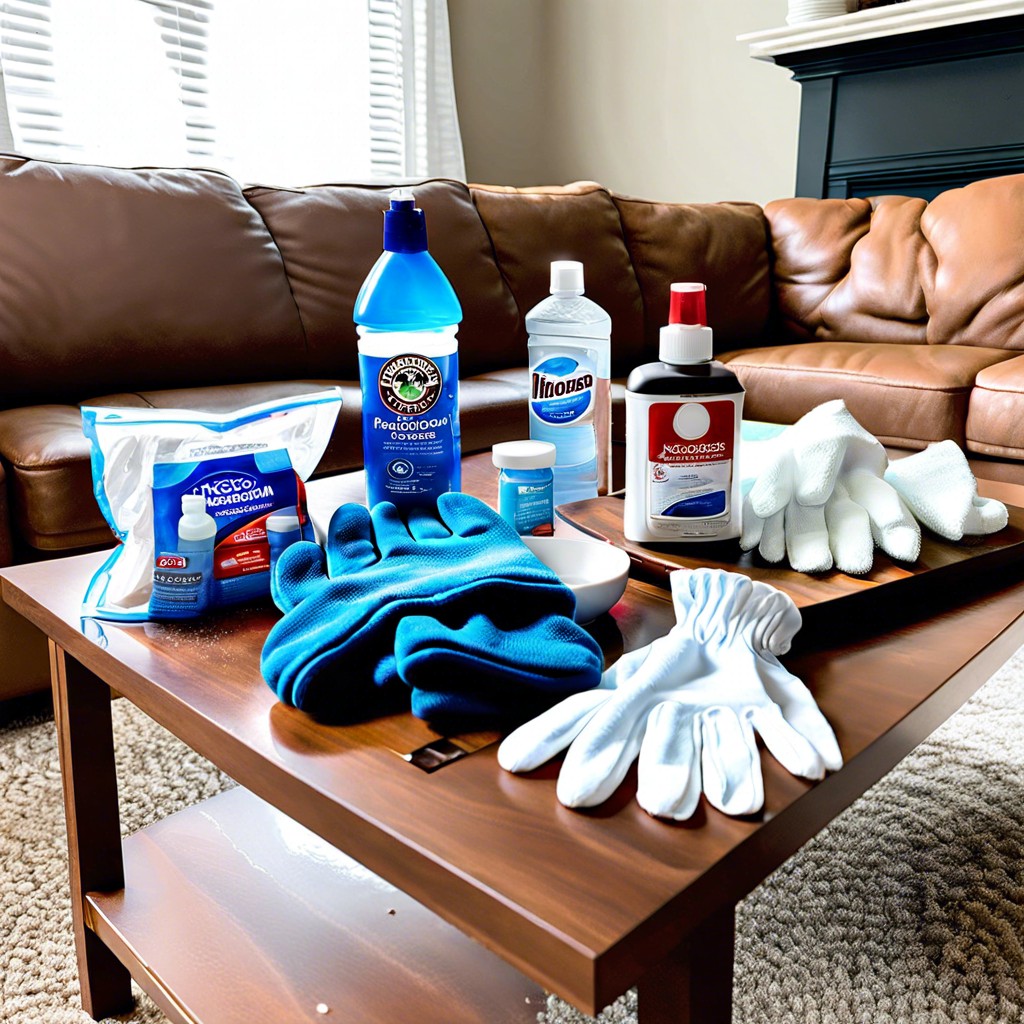Last updated on
Learn practical, effective methods for removing blood stains from your couch, ensuring your furniture maintains its pristine condition.
Key takeaways:
- Gather essential materials for stain removal
- Act quickly to prevent the stain from setting
- Use cold water and blotting technique for initial cleaning
- Enzymatic cleaners or hydrogen peroxide can be effective for stubborn stains
- Follow special care instructions for leather and suede couches
Table of Contents
Materials to Prepare

Before tackling the stain, gather the following essentials:
- 1. Clean white cloths or paper towels: Opt for colorless options to prevent dye transfer onto the couch fabric.
- 2. Cold water: Essential for diluting the blood, making it easier to lift off the material.
- 3. Enzymatic cleaner or hydrogen peroxide: These substances break down the blood proteins, aiding in stain removal.
- 4. A small bowl: Mix your cleaning solutions here to have them ready for use.
- 5. Mild dish soap: Useful for making a gentle cleaning solution if commercial products are unavailable.
Equip yourself with these items and you’re prepared to address the stain effectively, minimizing potential damage to your couch.
Immediate Action to Prevent Stain Setting
As soon as a bloodstain occurs, it’s crucial to act fast. The longer blood sits on the fabric, the more it will seep into the fibers, making it harder to remove.
Begin by gently dabbing the stained area with a clean, dry cloth to absorb as much blood as possible. Avoid rubbing, as this can spread the stain and push it deeper into the upholstery.
Focus on lifting the substance away from the material without applying too much pressure. This preemptive measure significantly increases the likelihood of completely removing the stain.
Once the excess blood has been blotted out, you’re ready for the next step in stain removal.
Cold Water Application and Blotting Technique
Begin by soaking a clean cloth in cold water and wring it out slightly, ensuring it’s not dripping wet. Press the damp cloth against the stained area, absorbing as much blood as possible without scrubbing, as this can push the stain deeper into the couch fabric. Replace the cloth with a fresh one as it picks up the blood, and continue the process until no more is being transferred onto the cloth.
Cold water is preferred over warm or hot since heat can cause the blood to coagulate, making the stain more difficult to remove. Blotting is the key action here; it gently lifts particles without spreading them. If the stain is fresh, this method can often remove it entirely. If the stain does not come out completely, this step will at least minimize its appearance and prevent it from setting, facilitating the use of more intensive cleaning agents afterwards if necessary.
Using Enzymatic Cleaners or Hydrogen Peroxide for Stubborn Stains
Enzymatic cleaners are a go-to solution for organic stains like blood, as they break down the proteins, making the stain easier to remove.
When choosing an enzymatic cleaner, ensure it’s suitable for upholstery to avoid any potential damage.
Apply the cleaner according to the product instructions, often involving letting it sit to do its work before blotting and rinsing.
If an enzymatic cleaner is not on hand, household hydrogen peroxide (3% solution) can be effective.
It acts as a mild bleach and is best tested on a hidden area of the couch first to ensure colorfastness.
Apply a small amount with a soft cloth directly on the stain, letting it bubble to lift the blood.
After a few minutes, blot and rinse with cold water.
Remember, hydrogen peroxide is suitable for light-colored fabrics as it might bleach darker materials.
Always use it with caution.
Leather and Suede Couch Special Care
Leather and suede are sensitive materials that require particular attention, as harsh cleaning methods can cause more damage than the bloodstain itself. Traditional water-based cleaning methods are risky as they can lead to water stains or discoloration.
1. For leather, a gentle approach is best. Dab the area with a clean, dry cloth to absorb the blood as much as possible. Avoid scrubbing, as this can push the blood deeper into the grain. Once you’ve absorbed as much as possible, consider a leather cleaner designed for stain removal. Apply the cleaner as directed, usually with a soft, damp cloth, working it into the stain gently.
2. Suede is even more delicate. Firstly, blot any excess blood with a paper towel. Then, use a suede brush to gently lift the fibers. For mild stains, a suede eraser can be effective at removing residue without adding moisture. For more stubborn bloodstains, a specialized suede cleaner is advisable – it’s formulated to break down the stain without harming the nap of the suede.
3. Conditioning the area post-cleaning is crucial for both materials. Leather conditioner for a leather couch, and suede protector for a suede couch, will help restore the natural oils and protective qualities of the material after cleaning.
Remember, always test any cleaner on a small, inconspicuous area first to avoid any surprises.




